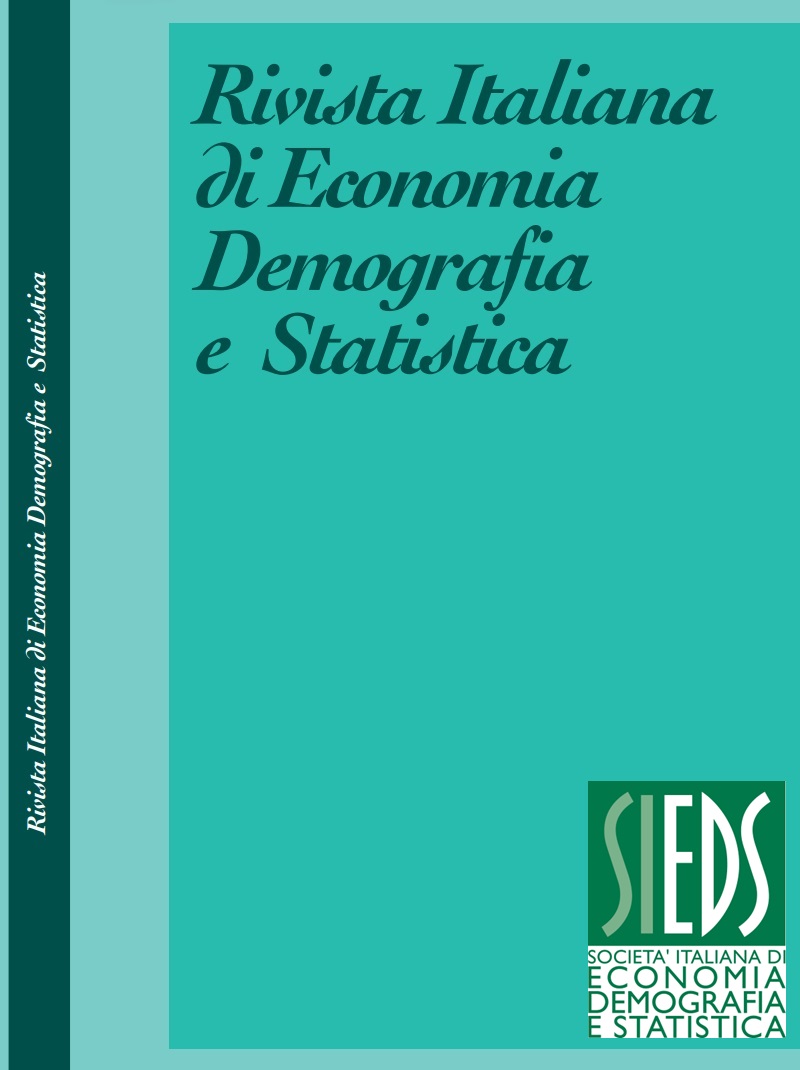A look at the local growth of the main foreign communities in Italy over the last twenty years
DOI:
https://doi.org/10.71014/sieds.v79i1.283Keywords:
foreign population, Exponential Growth Model, spatial patterns, spatial concentrationAbstract
In the field of population studies, the process of spatial concentration tends to raise multiple and diverse issues. For this reason, the spatial settlement of foreign nationals in Italy has gained increasing interest because of its effects on social cohesion, integration programs and urban dynamics. In this context, the main purpose of this study is to assess the spatial distribution of foreign nationals in Italy in the years 2003 to 2023. Following new insights and using a population growth model, the study aims to discover patterns of concentration or dispersion of the foreign population within the different municipalities and metropolitan cities of Italy, making a temporal comparison. The analysis strategy used to achieve the aim is based on a local spatial analysis applied to the exponential development patterns, in addition to the global spatial analysis. The analysis conducted in this study finds spatial inequalities in the pattern of foreign population growth, highlighting areas with different levels of urbanization in relation to the different foreign citizenships considered.
References
AMICO A., D'ALESSANDRO G., DI BENEDETTO A., NERLI BALLATI E. 2016. Lo sviluppo dei modelli insediativi: rumeni, filippini e cinesi residenti a Roma. Cambio. Rivista Sulle Trasformazioni Sociali, Vol. 3, No. 6, pp. 123–146. https://doi.org/10.13128/cambio-19262.
ANSELIN L. 1995. Local Indicator of Spatial Association. Geographical Analysis, Vol. 27, No. 2, pp. 93-115. DOI: https://doi.org/10.1111/j.1538-4632.1995.tb00338.x
BAILEY N. 2012. How spatial segregation changes over time: Sorting out the sorting processes. Environment and Planning A: Economy and Space, Vol. 44, No. 3, pp. 705–722. https:// doi.org/10.1068/a44330. DOI: https://doi.org/10.1068/a44330
BENASSI F., CARELLA M., MUCCIARDI M., NACCARATO A., SALVATI L. 2023. Spatial segregation in action? An empirical assessment of population concentration of foreigners and nationals in Italy, 2002-2018. International Migration Review. Vol. 0, No. 0. https://doi.org/10.1177/01979183231170808 DOI: https://doi.org/10.1177/01979183231170808
BENASSI F., IGLESIAS-PASCUAL R., SALVATI L. 2020. Residential segregation and social diversification: Exploring spatial settlement patterns of foreign population in Southern European cities. Habitat International, Vol. 101. DOI: https://doi.org/10.1016/j.habitatint.2020.102200
BONIFAZI C., CARUSO M. G., HEINS F., PAPARUSSO A., PANACCIONE D. 2018. Le traiettorie di mobilità: arrivare e muoversi in Italia. In PEREZ M. (Ed.), Vita e percorsi di integrazione degli immigrati in Italia, Rome: ISTAT, pp. 35-51.
BONIFAZI C., HEINS F., LICARI F., TUCCI E. 2021. The regional dynamics of internal migration intensities in Italy. Population, Space and Place, Vol. 27, No. 7, pp. 1-15. DOI: https://doi.org/10.1002/psp.2331
BORJA J., CASTELLS M. 2002. La città globale. Novara: De Agostini.
BREZZI M., DUMONT J-C., PIACENTINI M., THOREAU C. 2010. Determinants of Localization of Recent Immigrants Across OECD Regions. Paper for OECD workshop on Migration and Regional Development, 7 June 2010.
CASACCHIA O., DIANA P., STROZZA S. 1999. La distribuzione territoriale di alcune collettività straniere immigrate in Italia: caratteristiche e determinanti. In BRUSA C. (Ed.), Immigrazione straniera e multicultura nell’Italia di oggi, Vol. 2, Milan: Franco Angeli, pp. 75-103.
CASACCHIA O., REYNAUD C., STROZZA S., TUCCI E. 2022. Internal migration patterns of foreign citizens in Italy. International Migration, Vol. 60, No. 5, pp. 183–197. https://doi.org/10.1111/ imig.12946. DOI: https://doi.org/10.1111/imig.12946
COLOMBO A. D., DALLA ZUANNA G. 2019. Immigration Italian Style, 1977-2018. Population and Development Review, Vol. 45, No. 3, pp. 585-615. DOI: https://doi.org/10.1111/padr.12275
CONTI C., MUCCIARDI M., SIMONE M. 2023. Exploring the Settlement Models of the Main Foreign Communities Residing in Italy (2003-2021). Social Sciences, Vol. 12, No. 9, p. 524. https://doi.org/ 10.3390/socsci12090524. DOI: https://doi.org/10.3390/socsci12090524
DUNCAN O. D., DUNCAN B. 1955. A methodological analysis of segregation indexes. American Sociological Review, Vol. 20, No. 2, pp. 210-217. DOI: https://doi.org/10.2307/2088328
FERRARA R., FORCELLATI L., STROZZA S. 2010. Modelli insediativi degli immigrati stranieri in Italia. Bollettino Della Società Geografica Italiana, Vol. 13, No. 3, pp. 619–639.
FORCELLATI L., STROZZA S. 2006. Modelli insediativi delle comunità straniere in Italia: un quadro di sintesi. Rivista Italiana di Economia Demografia e Statistica, Vol. 60, No. 1-2, pp. 127-150.
FREEMAN L., PILGER J., ALEXANDER W. 1971. A Measure of Segregation Based Upon Spatial Arrangements, Honolulu, Mimeo, University of Hawaii.
ISTAT 2023. Retrieved from: http://dati.istat.it/Index.aspx?QueryId=19125
ISTAT 2022. Retrieved from: https://www.istat.it/storage/rapporto-annuale/2022 /Rapporto_Annuale_2022.pdf
MASSEY D. S., DENTON N. A. 1988. The Dimensions of Residential Segregation. Social Forces, Vol. 67, No. 2, pp. 281–315. https://doi.org/10.1093/sf/67.2.281. DOI: https://doi.org/10.1093/sf/67.2.281
MUCCIARDI M., BERTUCCELLI P. 2012. The impact of the weight matrix on the local indicators of spatial association: an application to per-capita value added in Italy. International Journal of Trade and Global Markets, Vol. 5, No. 2, pp. 133-141. DOI: https://doi.org/10.1504/IJTGM.2012.048529
MUCCIARDI M., PIRROTTA G., TOFFLE M. E. 2024. Measuring the spatial concentration of the main foreign communities residing in Italy using a new approach. Rivista Italiana di Economia Demografia e Statistica, Vol. 78, No. 1, pp. 142-154.
MUCCIARDI M., TOFFLE M. E., LUCCHESE G. 2021. Social inclusion of Sicily immigrants: an attempt to measure social integration. In GÜLERCE H., GIRASELLA E., SKOUFI M. (Eds.), Migration, Social Entrepreneurship and Social Inclusion, Naples: Editoriale Scientifica, pp. 135-155.
MUSTERD S. 2003. Segregation and Integration: A Contested Relationship. Journal of Ethnic and Migration Studies, Vol. 29, No. 4, pp. 623-641. DOI: https://doi.org/10.1080/1369183032000123422
STROZZA S. 2019. Immigration and foreign nationals in Italy: Evolution, characteristics and current and future challenges. In FRIGERI D., ZUPI M. (Eds.), From Africa to Europe. The political challenge of migrations, Rome: Donzelli Editore, pp. 297–330.
STROZZA S., BENASSI F., FERRARI R., GALLO G. 2016. Recent demographic trends in the major Italian urban agglomerations: the role of foreigners. Spatial Demography, Vol. 4, No. 1, pp. 39-70. DOI: https://doi.org/10.1007/s40980-015-0012-2
VOSS P. R. 2007. Demography as a Spatial Social Science. Population Research and Policy Review, Vol. 26, No. 5, pp. 457–76. DOI: https://doi.org/10.1007/s11113-007-9047-4
ZHOU Y. 1998. Beyond Ethnic Enclaves: Location Strategies of Chinese Producer Service Firms in Los Angeles. Economic Geography, Vol. 74, No. 3, pp. 228-251. DOI: https://doi.org/10.1111/j.1944-8287.1998.tb00114.x
Downloads
Published
Issue
Section
License
Copyright (c) 2025 Marina Amante, Massimo Mucciardi

This work is licensed under a Creative Commons Attribution 4.0 International License.



